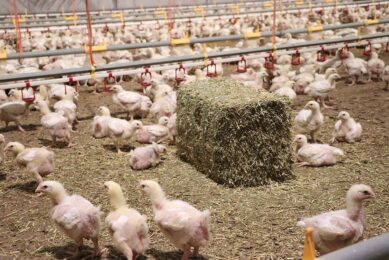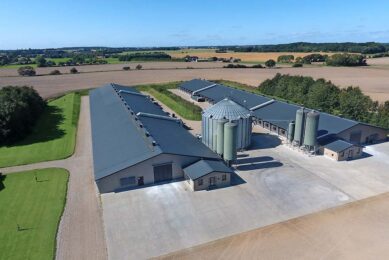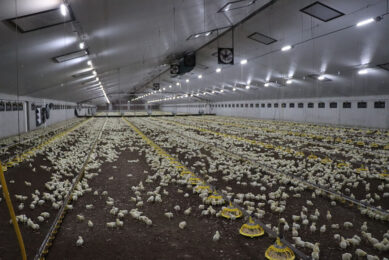Getting the most out of male broiler by-products

Father and son, Jan and Robin Nyboer, found a niche in fattening male by-products which they receive from Cobb Germany’s parent stock production. These Cobb 500 broilers need dedicated care and management but reach target weight 3 days earlier than regular broilers. Robin: “The average FCR of 1.55 and extremely good uniformity with lots of breast fillet outweighs all the effort we have to put in.”
Broiler farmers Jan and son Robin Nyboer are German poultry farmers living on the Dutch-German border. Their bilingual upbringing means they can easily connect with both Dutch and German suppliers, combining the best of both worlds.
Broiler farming is a family tradition dating back to Jan’s grandfather, who grew about 9,000 Arbor Acres broilers in 1964. Jan eventually followed in his grandfather’s footsteps, gaining experience working at a broiler farm in Wielen, Germany. In 1997, he was able to rent a farm in Wilsum with a capacity of 28,000 broilers (now 25,000 with a stocking density of 39 kg/m2). In addition, Jan applied for a job as manager of a broiler farm in Wielen, Germany, with 150,000 broilers in 3 2-story houses. He was able to rent that farm in 2012 and buy the facility in 2015.
Cobb 500
Nowadays, Jan runs most of the company located in Wielen with 150,000 broilers. Son Robin looks after the farm in Wilsum. Together, father and son have 175,000 broilers. Back in 2012 the farms housed Ross 308 broilers. Jan focused on day-old chicks from hatching eggs weighing less than 50 g, supplied by hatchery Cobroed.
“I got those day-old chicks 6.5 euro cents cheaper than the regular day-old chicks. That gave me a head start on cost price. Fattening the chicks went well and I achieved an excellent return,” says Jan.

The Nyboer family switched from Ross 308 to Cobb 500 in the spring of 2015. The Cobroed hatchery no longer wanted to sell day-old chicks from eggs under 50 g for less. In the search for cheaper day-old chicks, Cobroed connected Jan with Cobb Germany from Wiesenena (near Leipzig). Their day-old chicks are by-products from parent stock production and consist of 95% males and 5% females. With this choice, the Nyboer family deviated from the beaten path. That said, Jan and Robin think that Cobb has a very beautiful chick. Robin says this is mainly because of the growth, but also because of its health.
Different feed rations
Robin has had full responsibility for the farm in Wilsum since 2023. He partnered with Dutch feed company ABZ De Samenwerking. The 3 houses in Wielen are still supplied with feed by the Dutch compound feed company Agrifirm. Robin: “I decided to switch feed supplier and immediately apply a different feed strategy.” The FCR did not necessarily have to improve (although it did), because it had been good since 2015 with an average of about 1.65 at that time.

Until last year, the feeding strategy consisted of feeding extra wheat on top of the standard broiler compound feed in pelleted form, without giving any additives. About 10-15% wheat was added on top.
“We already knew that Cobb broilers in the US are fed relatively sparingly. We were considering trying that too, because this would make sense in terms of cost price,” said Jan.
However, the animals developed leg problems around 2018-2019. Solutions were discussed together with the Cobb representative and the nutritionist. It was necessary because these problems meant that approximately 3-5% could be culled – a significant cost factor. Robin consulted the sales manager (and former nutritionist) of ABZ De Samenwerking, Paul Arens. Working closely together, Paul and Robin made various adjustments to improve leg quality, weight and FCR.
Feed composition adjusted
Feed advisor Arens explained to the young German poultry farmer that the Cobb 500 chick needs less protein than a Ross 308 broiler, and that a Ross 308 broiler can also handle a concentrated feed more easily. By feeding wheat on top, you can reduce the overall protein content in the feed. However, this means that the Cobb 500 chick also consumes proportionately fewer minerals. “And it turns out that a Cobb broiler cannot handle that,” said Robin. “They need a certain amount of minerals in their feed to avoid any problems with their growth.”
Close consultation between Arens and Robin enabled them to solve the problems, thereby improving weight gain and FCR. Jan chuckles: “I’ll let Paul and Robin do their thing and if they solve the problem, I can apply their strategy in Wielen with the 150,000 broilers there.”
The solution consisted of abandoning the Ross 308 principles that are generally applied in Europe. So they have increased the calcium-phosphorus content and no longer add wheat on top.
“We no longer dilute the feed because by diluting with wheat you not only decrease the protein level but also the level of coccidiostats, vitamins and minerals,” said Robin. “We adjusted the feed itself to make it a less concentrated feed with all the necessary vitamins and minerals for Cobb broilers. Plus, the feed is not pelleted anymore but a crumbly feed. The reason for this is that the birds have to eat more often which strengthens their bones and improves uniformity even more. So we have actually developed a ration based specifically on the needs of the Cobb 500 broiler.”

Worth the effort
“The Cobb 500 broiler is very interesting for us because we usually get 95% males from Cobb Germany and 5% females. This ensures great uniformity with an extremely high fillet percentage. The processors that buy our chicks really appreciate this. We would never be able to achieve this level of uniformity with conventional Ross 308 chicks with mixed males and females (50-50),’’ says Jan.
Because the average daily gain of the Cobb chicks is higher, the grow-out period is also 3 days shorter. With an FCR of 1.55 on average with feed from ABZ De Samenwerking, this makes it worth the effort. The flock is thinned once, at about 4 weeks of age. Although the family does have a slightly higher mortality rate than average, this is not due to the quality of the broilers.
“That is because it is a by-product,” says Robin. “The day-old chicks have to be sexed and that means that they pass through human hands about 5 times before they arrive on farm. The stress that entails and the risk of damage to the intestines has a negative effect. The day-old chicks also come from a variety of broiler grandparent flocks. The mortality rate is 2.5-6%, on average.”

Climate settings
Management has also been adjusted. For example, the heat and ventilation in the house are adjusted differently than for Ross 308 broilers. Cobb chicks produce more heat, as they grow faster. As a result, the temperature in the house can be lowered sooner and slightly more ventilation is needed.
“But you have to keep an eye on it – too much air flow can result in respiratory problems,” says Robin. More water consumption because of the higher-than-average calcium-phosphorus inclusion demands a focus on water quality. As these Cobb broilers grow faster, their feed intake is also higher. Therefore, the water intake per m2 is also much higher than with a normal Ross 308 chick – especially with Robin’s stocking density of 22 birds per m2.
“This puts enormous pressure on the litter quality, so we are really sharp on that,” Robin notes. “I also apply a strict selection every day. This helps me to have a good overview and I can also keep a close eye on the health of the animals, too. Our tailored approach reaps the results we are looking for.”
 Beheer
Beheer











 WP Admin
WP Admin  Bewerk bericht
Bewerk bericht